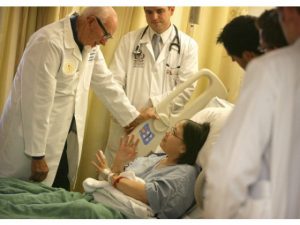This website uses cookies so that we can provide you with the best user experience possible. Cookie information is stored in your browser and performs functions such as recognising you when you return to our website and helping our team to understand which sections of the website you find most interesting and useful.

Susan E. Mazer, Ph.D. Blog
Thoughts and ideas on healthcare
Hi, and welcome to my blog! I'm Susan E. Mazer -- a knowledge expert and thought leader on how the environment of care impacts the patient experience. Topics I write about include safety, satisfaction, hospital noise, nursing, care at the bedside, and much more.
Does Whole Person Care Improve the Patient Experience?
November 4, 2016
 You want to provide the best care and experience for your patients, right? But are you simply going down the list of HCAHPS questions, using this 31-question survey as kind of a reverse operating manual?
You want to provide the best care and experience for your patients, right? But are you simply going down the list of HCAHPS questions, using this 31-question survey as kind of a reverse operating manual?
Or, are you also looking at whole person care or other models of care such as patient-centered care, patient- and family-centered care, or relationship-centered care?
Healthcare was not always person-centered. Not so long ago, the most important individual in the room was the doctor. Patients were looked at mechanistically, with the biology and physiology of the body being primary.
This came from the assumption falsely hypothesized by Rene Descartes that the mind neither could nor did influence or communicate with the body. In other words, the body and mind were separate from each other and never the twain shall meet.
Treating the Whole Person
We now know that attitudes, beliefs, and values affect us on a cellular level; that they can raise or lower our immune system, and that optimism is healthier than pessimism. We know that the placebo and nocebo effects are where beliefs and expectations result in a physiological response.
We also know that when stress moves into distress, the “fight or flight response” protects us — a physical boost, again, based on what our minds tell us.
Whole person care considers wholeness as optimal health. It defines the patient as fully human, a complex person, whose emotional, spiritual, intellectual, and physical needs have to be acknowledged and supported.
Thus, suffering is not ignored. Pain is treated holistically. Collaboration between patients and caregivers is paramount.
And, wholeness is more than curing and deeper than healing. Whole person care addresses co-morbidities and makes sure that all needed services are focused on the patient.
Unfortunately, the HCAHPS survey ignores all of this. It points to relationships that are fleeting and perceptions that may be distorted, and it reduces the whole experience down to “always,” “never,” “agree,” and “disagree.”
And, because of a collective upbringing on this “report card” paradigm, many healthcare professionals tend to practice to the questions, forgetting what is not there and how much of patient is dismissed.
It is not unlike a music teacher focusing on the right notes and correct rhythm while ignoring the question of whether music is actually happening. A computer can play the right notes and be rhythmically programmed. However, there is no music there unless the musician makes it happen.
Authentic Engagement is Key
So it is with nursing and medicine. You may become a robot to the HCAHPS survey, but human caring demands that you address the whole person and do so authentically.
Key to engaging in whole person care at the bedside is to see beyond symptoms and treatment to the person who is being treated.
Restoration of the whole person only happens when you create a therapeutic relationship that acknowledges and reinforces the identity of the patient beyond their condition. It is about treating the patient and the disease and considering the life-world where the two meet.
The big question is whether you are willing to expand beyond the narrow scope that defines your specialty in order to care more effectively for your patients. Whole person care demands this, and pretty soon patients will be demanding it as well.
Want to Know More About Whole Person Care?
Watch this free, 30-minute webinar on “C.A.R.E. for the Whole Person.” Or, download a whitepaper on “Whole Person Care and C.A.R.E.”
P.S. If you like this post, please do me a favor and share on LinkedIn, Twitter, Facebook, etc. Also to get automatic notices when a new post is published, subscribe (upper right). No spam – just great content. Thanks!










